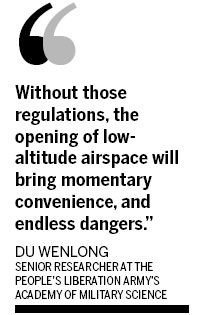Reforms to put safety first for low-level flights
By Li Xiaokun (China Daily) Updated: 2014-02-19 07:03
'Free navigation' unlikely for civil aircraft flying below 1,000 meters
China's reform of low-altitude airspace management will not introduce "free navigation" in airspace below 1,000 meters, People's Liberation Army air force spokesman Shen Jinke said on Tuesday.
The comment comes amid media speculation that a long-expected national regulation on the use and management of low-altitude airspace for general aviation will soon be released.
The new policy is expected to open a booming market for general aviation - such as small aircraft used for business - which is estimated to be worth more than 1 trillion yuan ($164.8 billion) annually.
The industry is a huge, yet untapped, part of China's civil aviation sector. But it will not get free rein, Shen said.
"Some people believe that our country's reform of low-altitude airspace management means totally free navigation in low-altitude airspace. That is one-sided and incorrect," Shen said in an article on the Ministry of National Defense's website.
In 2010, the State Council and the Central Military Commission issued a document to guide reforms.

The reforms, which are said to be in line with international practice, divide Chinese airspace below 1,000 meters into three types. Each is subject to a different management approach, but all are intended to streamline general-aviation flight plans.
The reforms are being tested in various areas nationwide.
Shen noted that in recent years some flights for commercial and entertainment purposes did not abide by the regulations and triggered crises.
In 2013, a technology company in Beijing made a flight for aerial photography without notifying authorities. When the plane flew near the capital airport, a number of large aircraft preparing to land had to make evasive maneuvers.
Aircraft violating regulations in recent years have included helicopters, unmanned aerial vehicles, model planes and delta-wing planes, Shen said.
He warned that balloons that are used for advertising might also be dangerous in some circumstances.
Du Wenlong, a senior researcher at the People's Liberation Army's Academy of Military Science, said that the further opening of low-altitude airspace must be based on guaranteed aviation security. "We need appropriate regulations, efficient management and enough experienced pilots who can meet the demands of this rapidly growing market," Du said.
"Without those regulations, the opening of low-altitude airspace will bring momentary convenience, and endless dangers."
Li Xiaojin, head of the Air Transport Economics Institute at Tianjin-based Civil Aviation University of China, said that despite some illegal flights, the government recognizes that the public's demand for greater freedom in low-altitude airspace is irreversible.
"The right way is to discuss how to efficiently meet the demand but not block it," Li said.
Shen promised on Tuesday that the authorities will promote efficiency in the handling of civil flight applications, once airspace order and security are assured.
Emergency flights for medical care, disaster relief and other urgent cases will get priority, he added.
China's air force is in charge of all domestic air traffic control, cooperating with relevant government departments.
Shen said military control is a necessity to ensure national security.
The air force monitors nearly 10 million military and civil aircraft flights annually, Shen said.
To support the civil aviation industry, the military has relocated 10 airports and designated 13 for civil aviation, Shen said. It also shares 63 airports with civil aviation.
In addition, it has closed 457 training areas and explored a number of new air routes totaling about 56,000 km.
lixiaokun@chinadaily.com.cn
(China Daily 02/19/2014 page4)
- More female officials caught in corruption
- Whampoa veterans recorded with glory
- Police bust 9 terrorist groups in Xinjiang
- Knife-wielding attackers seized in Xinjiang
- New regulation leads to drop in petitioned cases
- Hunan plant shut as probe into lead poisoning begins
- Police boost efforts to combat gambling
- Project offers jobs openings to legal experts
- Experts: Dog meat festival 'illegal'
- Nation looks to upgrade
pipeline networks






